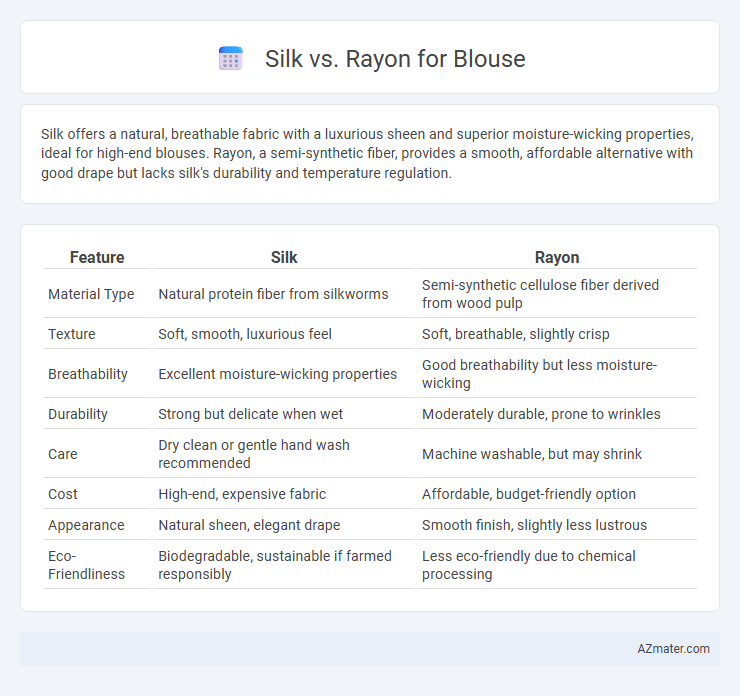Silk offers a natural, breathable fabric with a luxurious sheen and superior moisture-wicking properties, ideal for high-end blouses. Rayon, a semi-synthetic fiber, provides a smooth, affordable alternative with good drape but lacks silk's durability and temperature regulation.
Table of Comparison
| Feature | Silk | Rayon |
|---|---|---|
| Material Type | Natural protein fiber from silkworms | Semi-synthetic cellulose fiber derived from wood pulp |
| Texture | Soft, smooth, luxurious feel | Soft, breathable, slightly crisp |
| Breathability | Excellent moisture-wicking properties | Good breathability but less moisture-wicking |
| Durability | Strong but delicate when wet | Moderately durable, prone to wrinkles |
| Care | Dry clean or gentle hand wash recommended | Machine washable, but may shrink |
| Cost | High-end, expensive fabric | Affordable, budget-friendly option |
| Appearance | Natural sheen, elegant drape | Smooth finish, slightly less lustrous |
| Eco-Friendliness | Biodegradable, sustainable if farmed responsibly | Less eco-friendly due to chemical processing |
Introduction to Silk and Rayon for Blouses
Silk and rayon are popular fabrics used in blouse manufacturing, each offering distinct texture and appearance qualities. Silk, a natural protein fiber produced by silkworms, is renowned for its luxurious sheen, smoothness, and breathability, making it ideal for high-end and formal blouses. Rayon, a semi-synthetic fiber derived from cellulose, mimics the softness and drape of silk but usually comes at a more affordable price while providing good moisture absorption and color retention.
Fabric Composition Overview
Silk blouses are crafted from natural protein fibers produced by silkworms, offering a luxurious, smooth texture and excellent breathability. Rayon, a semi-synthetic fiber derived from cellulose, mimics the softness of natural fibers but tends to be more affordable and less durable than silk. Both fabric compositions impact the blouse's drape, sheen, and comfort, with silk providing superior luster and moisture-wicking properties compared to rayon's versatility and ease of care.
Texture and Feel: Silk vs Rayon
Silk fabric offers a luxurious, smooth texture with a natural sheen that feels cool and soft against the skin, making it ideal for high-end blouses. Rayon, a semi-synthetic fiber, mimics silk's softness but tends to be less smooth and may feel heavier or less breathable. While silk provides a delicate, crisp drape, rayon often feels more fluid and slightly thicker, impacting comfort and appearance in blouse fabric selection.
Breathability and Comfort Comparison
Silk offers superior breathability due to its natural protein fibers, allowing better moisture absorption and temperature regulation, which enhances comfort in warm weather. Rayon, though breathable and soft, tends to retain more moisture and may feel heavier on the skin compared to silk. For blouse wearers prioritizing lightweight comfort and effective moisture management, silk generally provides a more breathable and comfortable fabric choice.
Durability and Longevity
Silk blouses offer exceptional durability due to their natural protein fibers, which resist wear and tear better than rayon. Rayon, a semi-synthetic fiber, tends to weaken over time and is more susceptible to shrinking and damage from moisture. Choosing silk ensures longer-lasting fabric integrity and consistent performance in daily wear.
Care and Maintenance Requirements
Silk blouses require delicate hand washing or dry cleaning to maintain their natural luster and avoid damage from harsh detergents and high heat, while rayon blouses need gentle washing in cold water and air drying to prevent shrinking and fabric distortion. Both fabrics benefit from storing in breathable garment bags to avoid moisture buildup and fabric weakening. Proper care extends the lifespan and appearance of silk and rayon blouses by preserving fiber strength and color vibrancy.
Sustainability and Eco-Friendliness
Silk, derived from natural silkworm fibers, is biodegradable and renewable but involves high water use and potential harm to silkworms, raising ethical and environmental concerns. Rayon, a semi-synthetic fiber made from cellulose, often uses chemically intensive processes that contribute to pollution, though newer eco-friendly methods like lyocell production reduce environmental impact. Choosing sustainable blouse fabrics requires balancing renewable origin, processing techniques, and overall ecological footprint.
Cost and Value Analysis
Silk blouses typically command higher prices due to the natural fiber's luxurious texture and durability, offering long-term value through enhanced breathability and sheen. Rayon blouses, while more affordable, provide a cost-effective alternative that mimics silk's softness but tend to have lower durability and may require more delicate care. Evaluating the balance between initial cost and garment longevity helps determine the best fabric choice for budget-conscious consumers seeking premium appearance.
Best Occasions for Silk and Rayon Blouses
Silk blouses are ideal for formal events, weddings, and evening parties where elegance and luxury are desired due to their smooth texture and natural sheen. Rayon blouses suit casual outings, office wear, and daytime social gatherings because of their breathable fabric and affordability while offering a soft feel similar to silk. Choosing between silk and rayon depends on the occasion's formality, durability requirements, and maintenance preferences.
Final Verdict: Choosing Between Silk and Rayon
Silk offers unmatched luxury, natural breathability, and durability, making it ideal for high-end blouses that combine elegance with comfort. Rayon provides a budget-friendly alternative with smooth texture and good moisture absorption, suitable for everyday wear but less resilient over time. Choosing between silk and rayon depends on prioritizing either premium quality and longevity or affordability and practicality for blouse fabric.

Infographic: Silk vs Rayon for Blouse
 azmater.com
azmater.com